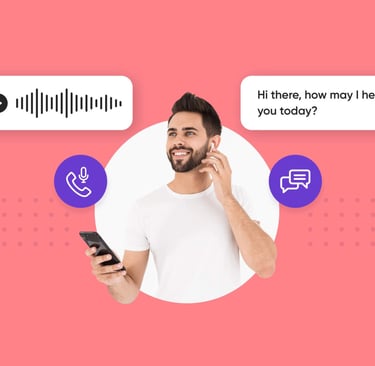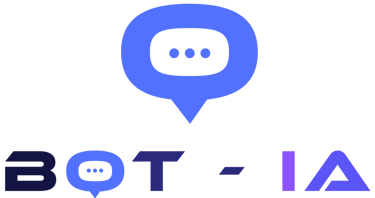Differences between Chatbot and Voicebot: Select the Best Option for your Company
This article explains the main differences between chatbots and voicebots, highlighting their features, advantages and use cases. Helps companies identify which technology is best suited to their customer service needs, and provides guidance on implementing effective, modern conversational automation solutions.
BOT-IA
5/9/20253 min read


In the digital age, where immediacy and personalization are key factors in customer experience, companies are constantly looking for new ways to optimize their attention and communication. In this scenario, two technologies have gained prominence: chatbots and voicebots. Although both perform similar functions, their characteristics, uses and benefits vary significantly.
In this article we explain the key differences between chatbots and voicebots, their advantages and use cases, to help you choose the best option according to your business needs.
What is a chatbot?
A chatbot is an artificial intelligence-based program that simulates a text conversation with users. It is commonly deployed on platforms like WhatsApp, Messenger, websites, mobile apps and social networks.
Using natural language processing (NLP) algorithms, chatbots can interpret questions, provide automated responses, execute actions (such as scheduling an appointment or processing an order), and maintain consistent conversations.
Main features of the chatbot:
Communication by text
Guided or free interaction
Easy integration with digital channels
Personalization and segmentation by user profile
Ability to scale multiple conversations in parallel
What is a Voicebot?
A voicebot, on the other hand, is a virtual assistant that interacts by voice. Uses speech recognition and synthesis technologies to understand what the user is saying and respond naturally.
This type of bot is used in phone calls, smart assistants (like Alexa or Google Assistant) or apps with audio support. Like chatbots, you can run automated tasks, but with a fully auditory interface.
Main features of the voicebot:
Spoken communication
Ideal for hands-free interaction (hands-free)
More accessible to people with visual or technological limitations
More human and intuitive experience
Requires integration with telephony systems or voice assistants
Key differences between chatbot and voicebot
Interaction mode: Chatbot: Text - Voicebot: Voice
Common channels : Chatbot: WhatsApp, web, social networks - Voicebot:Phone, voice assistants.
Accessibility: Chatbot:Requires reading/writing - Voicebot: Ideal for people with visual impairments or on the move.
Response speed: Chatbot: High (depends on flow) - Voicebot:High, more naturally.
Environment: Chatbot: Quiet or discreet spaces - Voicebot:Environments where talking is possible and comfortable.
Level of naturalness: Chatbot: Medium-high (according to IA used) - Voicebot: High (closest to human conversation).
Cost of implementation: Chatbot: Generally lower Voicebot:Higher, by voice integration.
Chatbot scalability: Very high - Voicebot: High, but with additional infrastructure.
Technical integration: Chatbot: Simpler - Voicebot: More complex (voice recognition, IVR, etc.).
Which option is best for your business?
The choice between chatbot and voicebot is not about which one is better in absolute terms, but which one best fits the model of attention, the type of customer and your business goals. Below, we discuss different criteria for making an informed decision:
1. Type of customer:
If your audience is used to using WhatsApp or social media, chatbot is more effective.
If your customers prefer to communicate over the phone or have visual impairments, voicebot is a better option.
2. Main channel of care
Companies with digital attention and integrated chats (for example, e-commerce, reservation services) benefit more from the chatbot.
Medical centers, transportation companies or institutions with high call load could opt for a voicebot to automate phone lines.
3. Type of interaction
For simple and guided flows (FAQ, forms, reservations), the chatbot offers a clear and controlled experience.
For freer interactions or complex queries that are better expressed by voice, the voicebot is more natural.
4. Resources available
The chatbot can be implemented quickly and at a lower technical cost.
The voicebot requires investment in voice technology, but it can make a difference in businesses with high call volumes or remote attention.
Why not both?
Many companies now combine chatbots and voicebots as part of an omnichannel strategy. For example, a user can start a WhatsApp conversation (chatbot), receive initial attention, and if he needs advanced support, be automatically transferred to a call managed by a voicebot.
This integration improves coverage, reduces operating costs and increases customer satisfaction by offering different media depending on your comfort and context.
BOT-IA: Intelligent conversational solutions
In BOT-IA we develop customized chatbots and voicebots that adapt to the needs of each company. We analyze your business model, the channels you use and how your customers interact, to offer you an efficient, secure and goal-aligned solution.
Whether you’re automating social media, web pages or phone lines, our virtual assistants help reduce the operational load, improve response times and generate positive experiences for your users.
Conclusion
Both the chatbot and the voicebot are powerful tools to transform the way a company communicates with its customers. Understanding their differences and advantages will allow you to make a strategic decision, aligned with your industry, your users and your budget.
If you’re looking to improve your attention without relying on a single channel, consider integrating both technologies and taking a step forward in conversational automation.
RESOURCES
CONTACT
Chatbots
COMPANY
Email: info@botia.com.co
Cell Phone: +57 314 2376428
SOCIAL MEDIA
Address: Carrera 32 #25 b 25 Oficina 101
Bogotá D.C, Colombia
SERVICES
Costum web page
Voicebots
